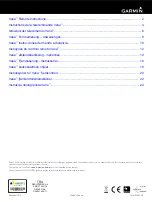
MSC..-1S..E
Supplement: MINI-SCREEN Models with Selectable Trip/Latch Output
P/N 68980
3
Banner Engineering Corp. • Minneapolis, MN U.S.A.
www.bannerengineering.com • Tel: 763.544.3164
The MINI-SCREEN controller must have a manual reset after power-up and after any
interruptions of the defined area. The location for the manual reset device (e.g., a normally
open keyed switch) must comply with the warning in Section 2.10(s); also refer to that section
for information on external key resets.
Latch Output is typically used in situations where an individual can pass completely through
the sensing field, so that the sensing field becomes clear and the MINI-SCREEN can not
prevent hazardous motion. See Section 3.2.1.1(s) Pass-Through Hazards.
Section 2.8 Addition
2.8(s) External Device Monitoring (EDM)
Two terminals are provided for monitoring the state of external devices such as MPCEs; see
Figure 20(s). These terminals are labeled “Mon a” and “Mon b” at TB2. The MINI-SCREEN
EDM inputs can be configured in two ways: one-channel monitoring, or no monitoring. See
Section 3.5.5(s) for external hookup.
One-Channel Monitoring: A series connection of closed monitor contacts that are forced-
guided (or captive contact) from each device controlled by the MINI-SCREEN. The monitor
contacts should open when the FSD outputs close (a clear condition), but this is not required.
The EDM input must be closed within 200 milliseconds of the FSD outputs opening (a blocked
condition) or a lockout will occur; see Section 5.1(s).
No Monitoring: The EDM input (“Mon a” and “Mon b”) must be jumpered if EDM is not used.
If the MINI-SCREEN is set for No Monitoring, the user must ensure that any single failure
of the external devices will not result in a hazardous condition and will prevent a successive
machine cycle (see Section 2.7, Control Reliability).
Section 2.9 Addition
2.9(s) MSA-RM-.. Relay Modules
The MSA-RM-1 relay module used in the model MSC..-1S2E control boxes has individual
normally open, forced-guided contacts from FSD1, FSD2 and SSD relays to form each
respective output (4 amps at 250V ac). Each FSD output consists of a single normally open
contact from one monitored relay; contacts from both relays must be used to ensure proper
operation. Both FSD outputs must be used, either in a dual-channel method as shown in
Figure 23a(s) or series-connected in a single-channel method, to control each individual
hazard.
The MSA-RM-2 relay module used in the model MSC..-1S3E control boxes has redundant
normally open, forced-guided contacts from FSD1 and FSD2 relays to form the FSD and CNC
outputs (6 amps at 250V ac). The SSD is an individual normally open, forced-guided contact
from the SSD relay (4 amps at 250V ac). See Figure 23b(s).
If the Complementary Normally Closed Auxiliary output (“CNC Aux”) is used as a stand-alone
output (it is not interfaced with one or both of the FSD outputs), it is a non-safety-related
output. The CNC Aux output is typically used for monitoring purposes and may not be suitable
for safety applications. The CNC Aux output status is the opposite that of the FSD1 and FSD2
safety outputs.
CAUTION . . .
No EDM
If the application does not require External
Device Monitoring, the EDM input must be
jumpered. It is the user’s responsibility
to ensure that this does not create a
hazardous situation.






























